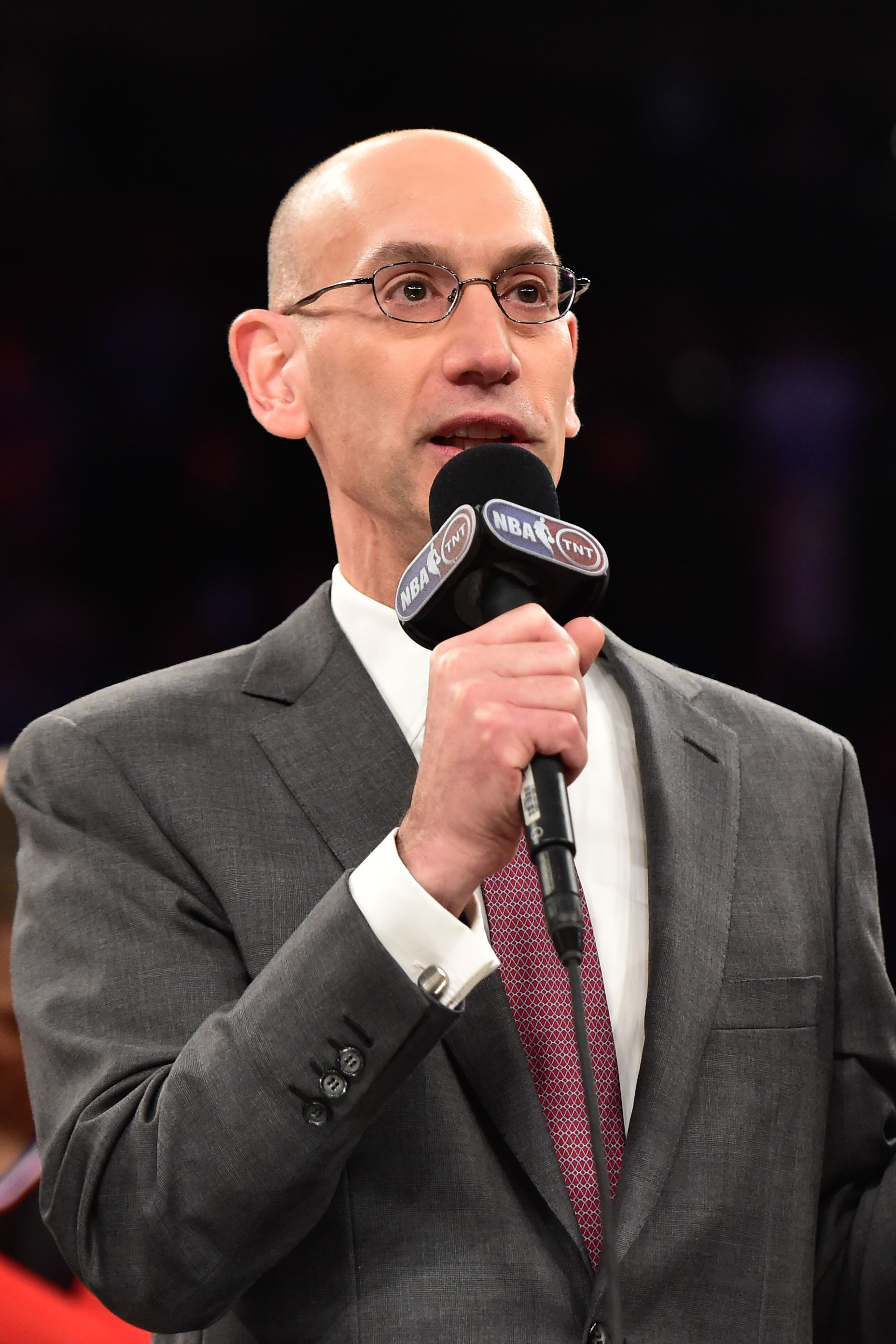NBA: Players union officially rejects ‘cap smoothing,’ sets stage for 2016 salary cap spike
The NBA announced Wednesday that the National Basketball Players Association has officially rejected the NBA’s plan to gradually phase in the enormous impending increase of revenues that will result from the league’s new $24 billion broadcast rights deal, an idea referred to as “cap smoothing.”
[DraftKings: FREE Entry to a Huge Cash Fantasy Basketball Contest with First Deposit. Draft your team now.]
NBA Commissioner Adam Silver had forwarded the “smoothing” proposal in recent months in hopes of avoiding what he feared might be a destabilizing effect on the league economy should the salary cap experience a massive year-over-year spike in the first season after the infusion of the new TV cash. The union, however, has expressed concern that agreeing to a smoothing plan could have unintended longer-term consequences on players’ earning power, which has led to a split between the two parties on the issue.
Here’s the league’s Wednesday statement, courtesy of NBA Executive Vice President of Communications Mike Bass:
“The National Basketball Players Association has informed the NBA that it will not agree to ‘smoothing’ in the increases in the Salary Cap that will result from the new national media agreements beginning in the 2016-17 season.”
“Smoothing would have avoided a substantial Salary Cap spike in 2016-17. Under the league’s smoothing approach, the salary shortfall resulting from more gradual Cap increases would have been paid directly to the Players Association for distribution to all players, and thus the total compensation paid to players in any given season would not have been impacted.”
OK, let’s back up a second.
When the new television deal kicks in for the start for the 2016-17 season, the league’s annual take from TV rights will nearly triple from $930 million per year to about $2.7 billion per year. The NBA’s salary cap is calculated each year based on a formula that includes projected amounts of basketball-related income, which includes TV money. Ergo, a giant infusion of cash would necessarily result in a monster year-over-year surge in the cap.
The exact amount of that projected — and now, it seems, all but inevitable — one-time leap isn’t yet clear. Some estimates have pegged the jump in the cap line from about $66.5 million in 2015-16 to somewhere between $80 million and $90 million for the ’16-’17 season. Such a mammoth jolt could drastically alter teams’ short- and long-term planning when it comes to salary structure, perhaps giving presently luxury-tax-paying or capped-out teams an opportunity to dig out from their past mistakes by adding talent for which they would previously have been unable to pay, and dramatically changing the landscape for those players who will reach free agency come the summer of ’16.
In order to minimize what he fears will be a shock to the NBA system, Silver proposed a change to the system by which salary cap figures are determined, as laid out in the collective bargaining agreement between the league and the players. The commissioner floated a compromise in which the cap line is held down — it would increase, but by a smaller amount than the actual revenue numbers would typically demand — over the next few seasons, with the difference between the actual amount of league revenue players were owed and the “smoothed” amount used to calculate the artificial cap line given to the union as a “shortfall payment” that would be split up and distributed to each player.
When the league pitched its plan to the NBPA — actually, the NBA sent the union two different versions of the smoothing proposal, according to NBA.com’s Steve Aschburner — executive director Michele Roberts and the rest of the union’s leadership enlisted two teams of forensic economists to evaluate the pros and cons for players. They were, apparently, unmoved.
“There is, and was, a concern about any proposal that results in limiting a player’s ability to realize as much income as they can,” Roberts said during an All-Star Weekend press conference announcing the union’s intent to reject the league’s proposal.
“The proposal that the league submitted […] would artificially deflate the salary cap. And that, of course, meant that players’ salaries would not increase as much as they would otherwise were it not for smoothing. That pretty much was what killed it. It killed it in the eyes of the economists that made the recommendations, and it killed it in the eyes of the players.”
At issue, though, is the question of which players benefit most from the apparent death of the smoothing plan.
The massive one-time infusion of cash that now seems likely to come and leave all 30 teams flush in the summer of 2016 seems like a really great deal for those players set to hit free agency that summer. It seems like less of a boon, though, for players whose contracts extend beyond that summer, and especially those players who are unlikely to reap the benefits of skyrocketing maximum salaries (which are calculated based on percentages of teams’ salary caps).
If you’re the kind of player more likely to scratch out a minimum deal or ink a pact for something like the room, biannual or midlevel exceptions — which are not tied to the cap line, but are instead determined as set figures in the CBA — you seem to get the shaft both in terms of what the one-time spike means for the cap and in the absence of those extra shortfall bonuses over the next few seasons. A quick take from salary cap guru Larry Coon:
You know who gets screwed the most from this? Rank and file players who don’t have many years left in the league. Under smoothing they would
— Larry Coon (@LarryCoon) March 11, 2015
…have gotten a big shortfall check in 2016-17. But this way, all the 2016 money goes to 2016 free agents. Playes need to be in the league
— Larry Coon (@LarryCoon) March 11, 2015
…past 2017 to reap the benefits. Players whose last years in the league are 2016-17 or 2017-18 will miss out. This is why I’m surprised
— Larry Coon (@LarryCoon) March 11, 2015
…that the union vote was unanimous to reject smoothing. I doubt if was a truly informed decision on the part of 450+ players.
— Larry Coon (@LarryCoon) March 11, 2015
This is the kind of concern that some — including our own Eric Freeman — have raised in the past about whether a players union led by stars, as the NBPA is with Chris Paul and LeBron James now occupying the union’s top two leadership spots, would tend toward policies that might be more financially beneficial to the comparatively few elite players than to the far more numerous mid-tier and lower-rung players.
[Follow Dunks Don’t Lie on Tumblr: The best slams from all of basketball]
At the All-Star Weekend presser, Roberts addressed the argument that accepting a multi-year smoothing plan would represent a more equitable distribution of the new TV revenue earmarked for players than a one-time spike, but claimed the NBPA’s economists projected that the long-term consequences of artificially lowering the cap would harm players’ future earning potential more than the short-term reality of shortfall checks would help them.
“At some point, when you are no longer constrained by a contract, and you’re now available to negotiate a contract, if we smooth, the amount of money that you’ll be able to negotiate will be less than what would be available had there not been smoothing,” Roberts said. “In other words, players’ salaries do not increase as rapidly under smoothing as they would when there’s no smoothing proposal, and the amount of the contract you’re able to negotiate is going to be less.”
Roberts left the door open to considering future league proposals after the union’s mid-February rejection, but apparently, no common ground was found:
After union rejected NBA’s initial cap-smoothing proposal at All-Star last month, the two sides met again yesterday, sources say. No deal.
— Ken Berger (@KBergCBS) March 11, 2015
In the here and now, this makes it much more likely that players do whatever they can to get to unrestricted free agency in the summer of 2016.
This summer’s crop of restricted free agents — All-Star Jimmy Butler, reigning NBA Finals MVP Kawhi Leonard, Draymond Green, Patrick Beverley, Khris Middleton, Tobias Harris and Enes Kanter, among others — could find themselves tempted to play out their one-year qualifying offer for the 2015-16 season rather than look for a long-term deal that would rule them out of participating in the summer of ’16. Those able to exercise player or early-termination options this summer — LeBron James, Kevin Love, Dwyane Wade, Monta Ellis, Goran Dragic, Luol Deng, Brook Lopez, Al Jefferson, Roy Hibbert and many others — might think about staying put for one more season, playing out the existing ’15-’16 portion of their deals, and hitting the market next summer.
That could, of course, also mean a quieter free agency period this summer. Teams with cap space this summer will have to decide whether to go all-in now before all 30 teams can back up Brinks trucks, or to keep their powder dry for what’s likely to be a much stronger and deeper, but also much more hotly contested, 2016 class.
Whether the one-year spike and expected attendant free-agent bonanza winds up benefiting the broader membership of the union remains to be seen, but if nothing else, it sets up a fairly fascinating bidding war in two summers’ time … and adds just one more contested issue to the stack of them likely to wind up under discussion if (or, more likely, when) either the league or the union elects to opt out of the current CBA come the summer of 2017.
More NBA coverage:
– – – – – – –
Dan Devine is an editor for Ball Don’t Lie on Yahoo Sports. Have a tip? Email him at [email protected] or follow him on Twitter!
Stay connected with Ball Don’t Lie on Twitter @YahooBDL, “Like” BDL on Facebook and follow Dunks Don’t Lie on Tumblr for year-round NBA talk, jokes and more.

